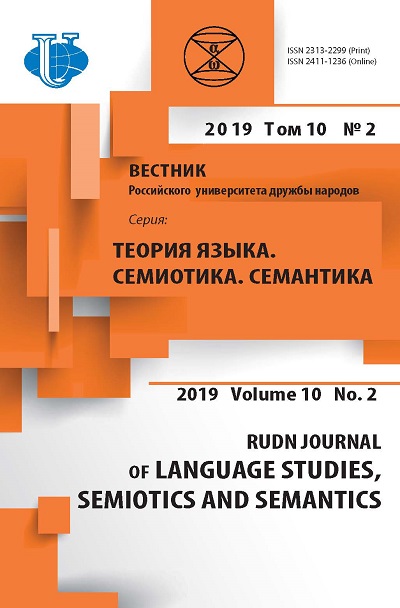THE CHURCH SEPARATION OF THE XVII CENTURY AS “NAMEEEEE” CONTENT: PRESENTATION OF THE PROBLEM OF COGNOMINAL EVENTS IN THE CULTURE (on the Material of Texts of the First Half of the Seventeenth Century)
- Authors: Zagumennov A.V.1
-
Affiliations:
- Budgetary Institution of Health Care of the Vologda Region “The Vologda regional center of medical prevention”
- Issue: Vol 10, No 2 (2019)
- Pages: 493-498
- Section: PRAGMALINGUISTICS
- URL: https://journals.rudn.ru/semiotics-semantics/article/view/21763
- DOI: https://doi.org/10.22363/2313-2299-2019-10-2-493-498
Cite item
Full Text
Abstract
The relevance of the proposed article is to rethink the semiotic trends in the light of a systematic approach. The aim of the work is to apply G.P. Melnikov's developments to the study of the Church separation of the second half of the XVII century as a reproducible event in the secondary modeling system. The General content of the work was prompted by the international scientific training “General and private methodology of philological science” held from 01.04.2009 to 06.04.2009, as well as some generalizations published in the collective monograph “System view as the basis of philological thought” (2016). The texts of the first half of the XVII century are used as materials. By means of observation, description, contextual analysis and elements of philological hermeneutics it is proved that the wholeformed event in culture has its own field of meanings capable of being segmented and having “pre-final” stages of its formation. It is concluded that the Church separation of the second half of the XVII century was a “hinted content”, a projection of individual creative consciousnesses that formed in the supra-system (social consciousness) a request for the implementation of semiotic trends.
Keywords
About the authors
Alexander V. Zagumennov
Budgetary Institution of Health Care of the Vologda Region “The Vologda regional center of medical prevention”
Author for correspondence.
Email: zaw1991@mail.ru
postgraduate student of the Department of Russian Language, Journalism and Theory of Communication Vologda State University
Oktyabrskaya Str., 40, Vologda, Russia, 160000References
- Melnikov, G.P. (2003). Systemic typology of languages: Principles, methods, models, L.G. Zubkova (Ed.). Moscow: Nauka. (In Russ.).
- Melnikov, G.P. (2014). Fundamentals of terminology. Moscow: LENAND. (In Russ.).
- Valentinova, O.I., Denisenko, V.N., Preobrazhensky, S.Yu. & Rybakov, M.A. (2016). Systemic approach to the basis of philological thought. Language. Semiotics. Culture. Moscow: YASK. (In Russ.).
- Melnikov, G.P. Preobrazhenskij, S.Yu. (1969) Methodology of linguistics. Moscow: UDN. (In Russ.).
- Chennakkadan, Dzh.V. The internal form and the grammatical status of the Russian compound words. New Delhi: Goyal Publishers and Distriburers PVT. LTD. (In Russ.).
- Valentinova, O.I., (2013). “The life of Archpriest Habakkuk”: to the interpretation of the theological part of life. Philological sciences. Scientific Essays of High Education, 5, 18—39. (In Russ.).
- Valentinova, O.I. (2016). Systemic approach to the study of text and style. In: O.I. Valentinova, V.N. Denisenko, S.Yu. Preobrazhenski, M.A. Rybakov. System view as the basis of philological thought. Moscow: YASK. pp. 171—302. (In Russ.).
- Research of speech-thinking activity (1974). M.M. Mukanov (Ed.). Alma-Ata. (In Russ.).
- Chronicle of the archaeological Commission in 1905 (1907). V.G. Druzhin (Ed.). Saint-Petersburg: Tipografiya M.A. Aleksandrova (Nadezhdinskaya, 43). (In Russ.).
- Russian historical library (1891). Archeological commission (Ed.). Saint-Petersburg. (In Russ.).
- Valentinova, O.I. (2016). Archetypal signs of medieval theological text and their transformation. Voprosy Kognitivnoy Lingvistiki, 3 (48), 109—118. (In Russ.).













